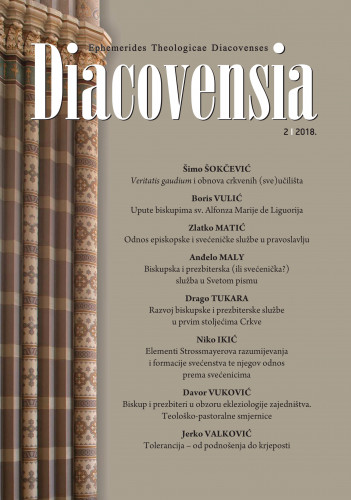Članak na indirektan način dotiče Crkvu kao instituciju i organizaciju, dok na neposredan način detaljnije pristupa predstavljanju onih koji čine dio crkvene hijerarhije, a to su biskupi i prezbiteri. Da bi se što bolje predstavilo i razumjelo postojanje i poslanje biskupa i prezbitera, potrebno je bilo, barem ukratko, istaknuti samu narav Crkve. Autor članak dijeli na tri poglavlja. U prvom poglavlju predstavlja Crkvu koja je imala svoje korijene u Starom zavjetu, a svoju puninu i utemeljenje pronašla je u Osobi Isusa Krista. Ona je prisutna u Božjem naumu još od starozavjetnih vremena, još kada su je proroci u slikama najavljivali. U drugom poglavlju autor se bavi biskupskom službom u prvo doba Crkve. O tome što su rekli crkveni oci o biskupima, o njihovoj ulozi i mjestu unutar prve Crkve te kako su ih definirali određeni sabori ili sinode obrađuje taj dio rada. Autor donosi osobna promišljanja i razumijevanje crkvenih otaca o biskupskoj službi, kao i određene kanone koji su nastali kao plod biskupskoga kolegijaliteta i jednodušnosti. Treće poglavlje govori o prezbiterima. Autor ponajprije predstavlja ulogu prezbitera u prvoj Crkvi, zatim naznačuje razvojni put od same terminologije pa do područja djelovanja u pojedinim trenutcima života Crkve. Prezbiter je stavljen u suodnos s biskupom, o njemu ovisi, ali s vremenom zbog novonastalih okolnosti on poprima određenu samostalnost unutar zajednice. Autor naglašava i važnost formacije i odgoja crkvenih službenika na teološkom i moralnom području.; The article implicitly addresses the Church as an institution and organization, while it directly and more explicitly presents those that make a part of Church hierarchy, bishops and presbyteries. To better present and understand the existence and mission of bishops and presbyters, it was necessary, at least briefly, to highlight the very nature of the Church. The author divides the article in three chapters. In the first chapter, he represents the Church that has had its roots in the Old Testament and found its fullness and foundations in the Person of Jesus Christ. She has been present in God’s plan since the Old Testament times when the prophets announced her in images. In the second chapter, the author discusses the office of bishops in the early Church. This part addresses what the Church Fathers said about bishops, and their role and place within the early Church, and how particular councils and synods have defined them. The author brings the Church Fathers’ personal reflections and understanding of the office of bishop as well as certain canons that have emerged as the fruit of bishop’s collegiality and unity. The third chapter talks about presbyters. The author first presents the role of presbyter in the early Church, and then indicates the developmental path from terminology itself to the area of action at particular times in the life of the Church. The presbyter is put in a co-relationship with the bishop, he is dependent on him, but in time, due to new circumstances, he has gained a certain autonomy within the community. The author also emphasizes the importance of formation and education of church officials in areas of theology and morals.
Sažetak

 Diacovensia : teološki prilozi : 26,2(2018) / glavni i odgovorni urednik, editor-in-chief Šimo Šokčević.
Diacovensia : teološki prilozi : 26,2(2018) / glavni i odgovorni urednik, editor-in-chief Šimo Šokčević.